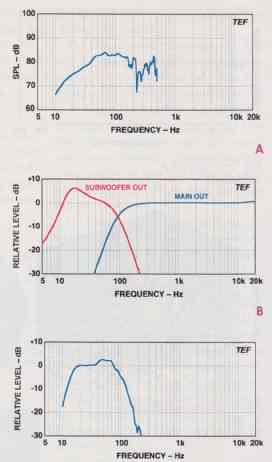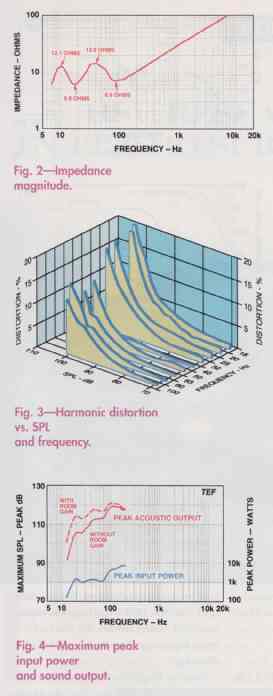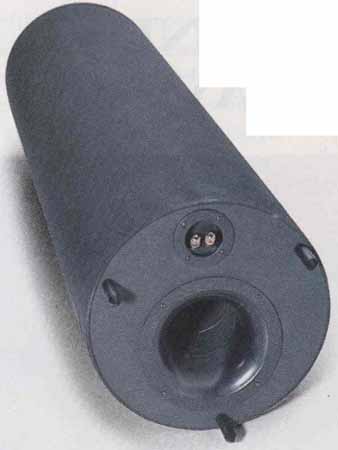I first met Dr. Poh Ser Hsu and heard his subwoofers during the 1992 Winter Consumer Electronics Show (CES) in Las Vegas. His demonstration setup was very modest: a portable CD player, an inexpensive receiver driving the main speakers (a set of small bookshelf speakers from Radio Shack), and an electronic crossover and similar receiver driving the tall, cylindrical, bottom-firing vented subwoofers. I was impressed by how good this unpretentious system sounded— and even more impressed when Dr. Hsu told me how inexpensive his subwoofers were! I subsequently included the smaller of the two subwoofers I had heard, the HRSW 10s, in a “Subwoofer Shoot-out” (Audio, November 1992), and liked them quite a bit.
Hsu Research now offers, by mail order only, five subwoofers (one of them powered) for home use, two power amplifiers, an electronic crossover, and sever al automotive sub- woofer systems and drivers. Two of these home systems, the HRSW 12V and HRSW 1OV—wide, short, cylinders that Hsu refers to as “coffee table” models magnetically shielded.
The TN models are similar to the earlier Hsu subwoofers—cylinders with very small footprints and bottom vents. However, the drivers in the TN models fire up from the enclosure tops. The smallest model, the TN 825, has an 8-inch driver and a rated frequency response that extends to 25 Hz. Next up is the TN 1225 HO, which has the same low-frequency limit but delivers higher output thanks to a 12-inch woofer. The TN 1220 HO, reviewed here, is the largest in the series and one of Hsu’s highest-output subwoofers. It, too, has a 12-inch woofer, but its rated frequency response extends down to 20 Hz.
The TN 1220 HO is housed in an acoustically inert tube of fiberboard, 47½ inches long, with a 12-inch inner diameter. The tube’s walls are only 1/8jflch thick, but its cylindrical shape makes it extremely strong and rigid. The enclosure’s simple shape and fiberboard construction are major reasons for the subwoofer’s low cost. The 12-inch woofer is mounted in top of the tube.
The bottom-firing port tube is very long at 28 inches. This 4-inch-diameter tube is also generously flared on both ends, expanding to a 6-inch diameter. The enclosure is stuffed with fiberglass to damp internal resonances and is entirely covered with black grille cloth. Surprisingly, the grille cloth does not cover the driver; instead, the owner’s manual gives the Radio Shack part number for a grille you can add if desired. On the bottom are a single pair of double- banana input terminals and three heavy- duty, pointed spikes, 2½ inches long and /8 inch in diameter. The spikes must be used to raise the enclosure enough for unimpeded airflow through the port.
---- SPECS ---
Rated Frequency Response: 20 hz to crossover, ±1 dB.
Rated Sensitivity 93 dB at 1 met 2.83 V rms applied in the mid to upper bass.
Rated Impedance: 4 ohms, nominal.
Rated Power Handling 250 watt, 18 Hz and up.
Dimensions: 51½ in. H (with spike x 12 in. diameter (130.8 cm H x 30.5 cm dia.).
Weight: 32 lbs. (14.5 kg) each.
Price: $450 each.
--- ---

--- ABOVE: Despite its 51-inch height, the TN 1220 HO’s column enclosure weighs
just 32 pounds.
The TN 1220 HO’s 12-inch woofer is a very beefy long-throw driver with a vented pole piece, a stamped frame, and two stacked ferrite magnets, 5¼ inches in diameter and ¾-inch thick. The cone is made of conventional felted paper, with a stiff foam surround.
While more and more subwoofers now have built-in amplifiers, Hsu offers external power amps with built-in crossovers for all its woofers except the TN 825, which has an amplifier built in. (A $50 discount is offered to those buying a subwoofer and an amp together.) Hsu takes this path because external amplifiers run cooler than those built into woofers, permit use of short line-level cables to the subwoofer amp (though you must then use longer speaker cables), and enable you to place the subwoofer amp’s controls conveniently near those of your other components.
I did not test a Hsu amplifier, as the company is replacing its more elaborate, 250-watt amplifier with a model that will produce about 400 watts and should sell for about $550. The existing 150-watt amplifier, which re mains in the line at $225, has a variable low-pass filter with a 12- dB/octave slope. However, the old and new high-power amps have built-in Linkwitz-Riley crossovers with 24-dB/octave slopes; the standard crossover frequency is 91 Hz, but plug-in resistor modules are available for frequencies from 28 to 155 Hz.
The new amp/crossover was not available when I tested the TN 1220 HO. But essentially the same crossover is available separately for $450. So, I used that with an amp of my own. The Hsu Research Electronic Crossover (it has no model number) is very compact, about the size of a 5- inch stack of letter-sized envelopes. It has a subwoofer-level control and switches for polarity and bypass. The crossover’s high- pass filter uses discrete FETs with zero feedback, and its subwoofer filters feature bi-FET op-amps with high slew rates, all biased in Class A. All the capacitors are 2% polypropylene film types, and 1% metal- film resistors are employed exclusively. Connections are unbalanced, via gold-plated RCA jacks.
Measurements
To assess the Hsu Research TN 1220 HO’s frequency response, I made ground- plane measurements, placing my test microphone 2 meters from the port and the driver. The results are essentially identical to those from standard, 1-meter, anechoic measurements.
Figure 1A, made with no crossover filtering or equalization and no curve-smoothing, shows fairly flat response between 45 and 160 Hz, with a 6-dB/octave rolloff be low 45 Hz that becomes steeper below 15 Hz. Above 160 Hz, the response is quite rough and choppy. The high-Q dip at 230 Hz reflects the primary organ-pipe resonance of the port tube, whose length is approximately one-half this wavelength. Aver aged over the 1220’s flat-response region, sensitivity is 82.5 dB SPL for the 2.83-volt input signal, significantly below Hsu’s 93-dB rating.
The Hsu Electronic Crossover’s response (Fig. 1B) confirms that it uses the classic Linkwitz-Riley alignment, whose outputs sum to unity gain when combined. (The acoustical outputs of speakers will generally not combine so neatly, of course, because of variations in their individual magnitude and phase characteristics.) The rapid, 24- dB/octave slopes should minimize response overlap between the subwoofer and satellite speakers. At the other end of the subwoofer output’s bandpass is an underdamped, second-order 1 2-dB/octave high-pass filter with a 6-dB peak at 17 Hz. This filter rolls the response off rapidly below the woofer system’s tuning point, to minimize cone excursion at infrasonic frequencies. It also adds a touch of equalization, flattening the subwoofer’s low-frequency response.
This flattening can be seen by comparing the subwoofer’s response with the crossover (Fig. 1C) and the unequalized response seen in Fig. 1A; the —3 dB points are now at 15 Hz, which is quite low, and 91 Hz. The upper rolloff point coincides exactly with Hsu’s rated crossover frequency (even though the electrical crossover seen in Fig. 1B is 95 Hz), and the rolloff itself eliminates the upper-frequency roughness seen in Fig. 1A.

Fig. 1—Frequency response of subwoofer (A), electronic crossover (B), and
subwoofer with crossover (C).

Fig. 2—Impedance magnitude.
Fig. 3—Harmonic distortion vs. SPL and frequency.
Fig. 4—Maximum peak input power and sound output.
A plot of the TN 1220 HO’s impedance magnitude (Fig. 2) displays the double humps typical of vented boxes. The impedance minimum, 5.9 ohms, occurs at 17.5 Hz, the approximate vented-box tuning frequency. The peaks of 12.1 and 13.9 ohms are reached at 10 and 40 Hz. The voice coil’s inductance causes the steady rise in impedance above 200 Hz. Below 200 Hz, the impedance variation is only 2.4 to 1 (13.9 divided by 5.9). To keep cable-drop effects from causing response peaks and dips greater than 0.1 dB, an extremely tight spec for a subwoofer, cable series resistance should be limited to a maximum of about 0.12 ohm. For a typical run of about 10 feet, that would correspond to 18- gauge (or larger) cable.
The effects of frequency and output level (including room gain) on the TN 1220 HO’s harmonic distortion are shown in Fig. 3. Note that the lowest test frequency is 16 Hz, not the 20 Hz I’ve used in prior subwoofer re views. The distortion presented is the sum of the first 10 harmonics, expressed as a percentage of the power in the fundamental. This method yields essentially the same results as total harmonic distortion (THD), but uses only the first 10 harmonics and does not include noise.
Although the measured distortion reached 10% to 20% at full power, the TN 1220 HO sounded quite clean because the second and third harmonics predominated. Distortion at 40 Hz was significantly lower than in the other bands, reaching only 7.2% at a high 108 dB SPL, the highest sound level reached at any of the frequencies exhibited here. At 16 Hz, the fundamental rose to an impressive 104 dB, although distortion was a fairly high 22% at that level. Very few subwoofers have much usable output at 16 Hz, but the Hsu had enough output there (and at 20 Hz) to vibrate every loose object in my listening room.
When I drove the TN 1220 HO with a high-level swept sine wave, its cylindrical cabinet exhibited no wall vibrations whatsoever—surprising rigidity, considering its large size and very light weight. Nor could I hear any wind noise caused by vent turbulence, even at the highest input levels and near box resonance, where air velocity through the port is highest. A strong dip in the woofer’s excursion at 18 Hz confirmed that the speaker’s box resonance was at about that frequency. In free air, the woofer’s maximum excursion was about 1 inch peak to peak at 20 Hz. When the woofer was remounted in the box and energized at high levels, I observed some inward dynamic offset between 60 and 80 Hz.
I’ve plotted the TN 1220 HO’s short-term peak power input and sound output (Fig. 4) from 12.5 Hz up instead of from the 20 Hz I’ve used for other subwoofers. The Hsu’s peak power input capability starts fairly high, at 150 watts at 12.5 Hz, then rises through 660 watts at 16 Hz to a high of 1.35 kilowatts at 20 Hz, then stays at about 1 to 1.2 kilowatts from 25 to 75 Hz. At higher frequencies, the input power rises rapidly, reaching 6,550 watts at 200 Hz.
With room gain, the maximum peak acoustic output starts with a very high 101 dB SPL at a very low 12.5 Hz, passes through 110 dB SPL at 16 Hz, then rises rapidly to a local peak of 114 dB at 20 Hz. After a slight dip to 113 dB SPL at 25 Hz, the output rises to 117.5 dB at 50Hz, heading up (after another slight dip) to 120 dB at 95 Hz before falling slightly to 118 dB at 200 Hz.

---ABOVE: The long, bottom-firing port tube flares to a 6-inch diameter.
The Hsu Research TN 1220 HO’s output at 25 Hz is the loudest, if perhaps not the cleanest, of any subwoofer I have tested. At 30 Hz and above, however, several speakers and subwoofers can play louder. Overall, the Hsu’s low-frequency output is still well into the top 10% of all subwoofers and speakers I have tested.
Use and Listening Tests
The tubular Hsu TN 1220 HO is distinctively different from the usual cube sub- woofers. When I unpacked the Hsu, I was pleasantly surprised at its light weight. It’s very easy to pick up and move around: Just lift it, bear-hug style, and move it where you want it. To move it farther distances, you can flip it on its side and carry it under one arm. The speaker’s grille-cloth cover may shift and wrinkle if you use the bear-hug technique, but it can easily be smoothed out.
One of the first things I did when I unpacked the subwoofer was to check the length of its port tube by physically reaching into the port with my hand and arm and trying to find its end. The port handled the full length of my arm without my hand touching its end; long indeed! (Actually, I was glad I was easily able to get my arm out. I would look stupid with my arm stuck in the bottom of the latest subwoofer I was re viewing for Audio!)
The top-mounted driver, however, makes the 1220 quite top-heavy and susceptible to tipping, as the brief owner’s manual warns. The manual covers unpacking procedures and subwoofer placement, as well as troubleshooting, and it adequately explains how to connect the subwoofer to many types of home theater and music systems. In addition to the warning about tipping, the manual cautions you not to set the 1220 upright on hard floors, such as tile or concrete, without putting a throw rug, felt pads, or rubber cups under the pointed feet to keep them from vibrating. Apparently, the cabinet’s rigidity helps the driver’s reaction forces travel to the floor, but its weight is too low to keep those vibrations from making it jump around when the 1220 is playing loud!
I evaluated the Hsu subwoofer in my home theater setup with both video soundtracks and music, feeding the out put of the Hsu Electronic Crossover through a Crown Macro Reference amplifier that powered the TN 1220 HO through a 5-foot length of 16-gauge zip cord. For comparisons, I used the Paradigm Servo 15, the best-performing sub- woofer I have reviewed to date (Audio, April 1998), which I fed through its own crossover and amp. The other speakers in my home theater setup were all KEFs: Reference Four main speakers, a Model 200C in the center, and Reference Twos for surround. I set up the Paradigm and Hsu subwoofers side by side in one corner at the front of the room. The Paradigm’s woofer and the bottom center of the Hsu were each approximately 2 feet from the corner. (Hsu’s manual suggests that placing the TN 1220 HO near your listening position may also work well.)
Initially, I listened to selections culled from Hsu’s very useful list of CDs and laserdiscs carrying deep bass signals. The TN 1220 HO demonstrated that it could keep up with the best subwoofers I’ve had in my listening room; its output at very low frequencies was second to none, while its bass re serve capabilities, smoothness, and extension were excellent. On a broad range of program material, the TN 1220 HO was able to handle, most capably, just about everything I threw at it. And although I listened mostly to CDs, the first 10 minutes of the Terminator 2: Judgment Day laserdisc demonstrated how ably the TN 1220 HO could handle even the very demanding low-frequency effects in the “Future War” chapter.
The Hsu subwoofer competed very well with the Paradigm, its maximum clean out put being a bit greater at the lowest frequencies and about equal at the higher end of its range. The Paradigm was somewhat cleaner in the upper bass, but I could hear this difference only on music that hadn’t much upper-frequency content to mask it; it was audible on solo bass guitar or pipe- organ pedal notes, but not when the organ had all its stops out.
On band-limited pink noise in the 16- and 20-Hz bands, the Hsu’s output was impressively high, bordering on scary— enough, actually, to shake the walls and al most everything attached to them.
Hsu’s larger amplifier has a soft limiter that matches the capabilities of the Hsu subwoofers (so will its replacement, though without the current model’s limiter-defeat switch), to minimize overload problems. With my amp, which has no such limiter and is about twice the power of Hsu’s larger one, I could audibly overload the TN 1220 HO when I played bass-heavy recordings very, very loud.
The larger Hsu amplifiers, old and new, are also designed to drive two subwoofers in parallel. Although I didn’t have a Hsu amp, I did have a second TN 1220 HO. I therefore did some listening with both subwoofers set up side by side, which increased the bass re serve quite significantly. At normal bass levels, the 1220s just coasted along, but on such demanding material as pipe-organ pedal notes, they delivered louder, deeper bass than any other subwoofers I had avail able. Two TN 1220 HO subwoofers and a single Hsu amp would give you a very cost- effective subwoofer system with very high output for less than $1,500.
The Hsu Research TN 1220 HO is distinctively different from most other sub- woofers. Its combination of slim tubular styling, light weight, small footprint, high output down to the lowest frequencies, and very modest price make the TN 1220 HO a winner. It does what a real subwoofer should do, providing large amounts of butt-kicking bass, all the way down to the 15-Hz region. It will please both the classical pipe-organ enthusiast and the rock ‘n’ roller. Still not enough bass? Buy two—they’re inexpensive enough!
Also see: wikipedia.org/wiki/HSU_Research
Adapted from 1998 Audio magazine article. Classic Audio and Audio Engineering magazine issues are available for free download at the Internet Archive (archive.org, aka The Wayback Machine)